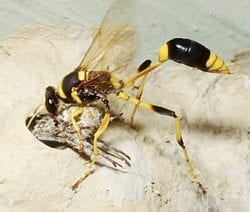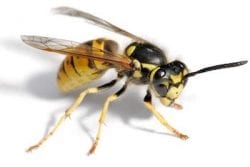Wasp and Bee Profiles

Australia is a hotspot for bees and wasps, boasting over 1500 species of native bees to pollinate our beautiful nation. Unfortunately, a few species have ruined it for the majority of relatively peaceful buzzers, occasionally threatening the homes and businesses of Canberrans with their large nests and larger colony numbers. Of the different types of bees we run into, the commercial honey bee, or European honey bee, is responsible for many calls we receive. In addition to this sweet-treat making insect, the European Wasp, Paper Wasp and Mud Wasp are the most common types of wasps in Australia, lancing many unsuspecting people with their barbs every spring and summer. Learn more about the usual suspects of the bee and wasp world below and remember – never try to get rid of a wasp nest or beehive yourself.
Wasp and Bee 101: What is the Difference between Wasp and Bees?
They both have wings (some of them), they all pack a mean sting when provoked and they have a common affinity for sweet things (one makes honey, the other steals honey from bees or kills the bees themselves for their sugary tasting bodies), how different can they be?
Wasps and bees are cousins, occupying the Hymenoptera order along with ants. Wasps are sleek bullets while bees are hairy push-overs, preferring the taste of flowers over other insects. One is the hunter, the other the hunted. One speeds around as the other ambles and stops to smell the roses. While a Ford Camry and a Ferrari 488 are both cars, they’re hardly comparable in class and the same can be said for bees and wasps.
Wasp Profiles
European Wasp

(Vespula Germanica)
Appearance: Black on their front with yellow markings and bright yellow on their back with black stripes. They also have bright yellow legs.
Size: Worker wasps will grow from 1.2 to 1.7 centimetres in length, while queens are much larger, but rarely seen outside the hive. Wasps can be easily distinguished from bees on first sight, as they are less hairy and have longer, leaner bodies.
Lifecycle: They mate in Autumn and in winter the entire colony dies except for the queen, who emerges in spring to begin laying eggs. The worker wasps will begin to build the nest and will usually finish in summer. Worker wasps will only live for a few weeks, but queens will live for around a year.
Habitat: In the wild, European wasps usually make their nests in the ground, but in buildings they can be found inside roof spaces or walls and under eaves.
Paper Wasp

(Polistes Humilis)
Appearance: Black with dull yellow stripes and a yellow face, not as bright as the European wasp.
Size: Worker wasps grow from 1 to 1.5 centimetres in length, with queen wasps growing larger. Paper wasps have long, thin legs and slender body.
Lifecycle: There are usually around 2 queens in a paper wasp colony. Nests are either built or reused by worker females in the spring, who then produce more worker females throughout the summer. Towards the end of the summer and in early autumn, the male workers are produced and the queens emerge from hibernation.
Habitat: Paper wasps are found all along the east coast of Australia and in South Australia. The workers wasps gather plant stems and dead wood which they mix with saliva to create the paper-like material of their nests. Their natural environment is in shrublands, but around human dwellings their nests can be found inside roof spaces, under eaves and attached to the outside of buildings.
Mud Wasp

(Sceliphron Laetum)
Appearance: They are bright yellow with large black bands around the abdomen and thorax and some black markings on the legs.
Size: Slightly larger than their European or yellow jacket cousins, worker mud wasps will grow from 1.7 to 3 centimetres in length, with the queen being the largest in the hive. The mud wasp can be easily distinguished by its thin, stick-like petiole protruding out from the thorax to the abdomen.
Lifecycle: The female will construct a mud nest using dirt and water collected from nearby. After mating, the eggs are placed in separate compartments of the nest with several paralysed spiders for the larvae to feed on when it hatches. After emerging as adults, the young wasps begin the same process again.
Habitat: They build nests out of collected mud, especially clay mud. You will find them inside wall and roof cavities and under eaves, where they are sheltered but have had close access to an outside mud source.
Yellow Jacket Wasp

(Vespula Germanica)
Appearance: Black on their front with yellow markings and bright yellow on their back with black stripes. They also have bright yellow legs.
Size: Worker wasps will grow to around 1.3 centimetres in length, while queens are much larger but rarely seen outside the hive. Yellow jacket wasps are very similar in appearance to European wasps, except they have three tiny black dots on their clypeus (face).
Lifecycle: The queen will initiate a nest and it will grow throughout late autumn and summer as more and more worker bees mature. Worker wasps will only live for a few weeks, but queens will live for around a year or even more. Unlike their European counterparts, yellow jacket wasps in Australia will often survive winter to form a larger, polygynous nest for the next year.
Habitat: In the wild, yellow jacket wasps usually make their nests below ground in the soil, but in buildings they can be found inside roof spaces or walls and under eaves.
Asian Paper Wasp

(Polistes Chinensis Antennalis)
Appearance: The Asian paper wasps have similar markings to their Australian relatives, but their colours are a more vivid black and yellow.
Size: Worker wasps grow from 1.3 to 2.5 centimetres in length, with queen wasps growing larger. Asian paper wasps look very similar to Australian paper wasps, with long, thin legs and slender bodies.
Lifecycle: There are usually around 2 queens in a paper wasp colony. Nests are either built or reused by worker females in the spring, who then produce more worker females throughout the summer. Towards the end of the summer and in early autumn, the male workers are produced and the queens emerge from hibernation.
Habitat: The Asian paper wasp is a highly invasive species in Australia; they compete with many local species and can be very aggressive towards humans. As well as in shrublands, their nests can be found inside roof spaces, under eaves and attached to the outside of buildings.
Bee Profiles
European Honey Bee

(Apis mellifera)
Appearance: Dark brown legs and body with yellow bands around the body. Bees are normally coloured a duller yellow than wasps.
Size: Honey bees are usually oval shaped and more round than wasps. Worker bees grow to around 1.5cm in length but queen bees are bigger.
Lifecycle: Each colony contains only one queen bee, which can produce around 2000 eggs a day. The rest are worker bees who build the hive, collect pollen and feed the larvae. Worker bees only live for around 1 to 10 months, but queen bees can live 3 to 5 years.
Habitat: In the wild, they build their hives in hollow trees or on branches. In buildings, hives can be found inside roof spaces or walls, under floors and attached to the outside of buildings. Honey bee hives are made of wax and can be very heavy, causing structural damage.
Mortar Bee

(Genus Osmia)
Appearance: Mortar bees vary in colour depending on the species. Most will be similar in colour to honey bees, with yellow/orange and black stripes on the abdomen, but others can be red, black or even blue.
Size: Like honey bees, mortar bees have stout, oval shaped bodies with translucent wings and depending on the species, may be very furry or not at all.
Lifecycle: Mortar bees live alone, have no queens and every female is fertile. After mating, the male dies and the female searches for crevices in which to build a nest, with some species excavating the crevice further. The eggs are laid in separate compartments within the nest and after hibernating, will hatch in the summer.
Habitat: In the wild, Mortar bees create nests within hollow twigs or cavities in soft stone or dry mud. They will often excavate long, narrow nests in soft stone brickwork and mortar. A mortar bee will very rarely sting but a serious infestation can cause significant structural damage.
Bid goodbye to problem bees and wasps with Canberra Pest Control today. We’re dedicated to making your home or workplace a safer place all year round. Don’t get into infestation – contact our experienced technicians today.